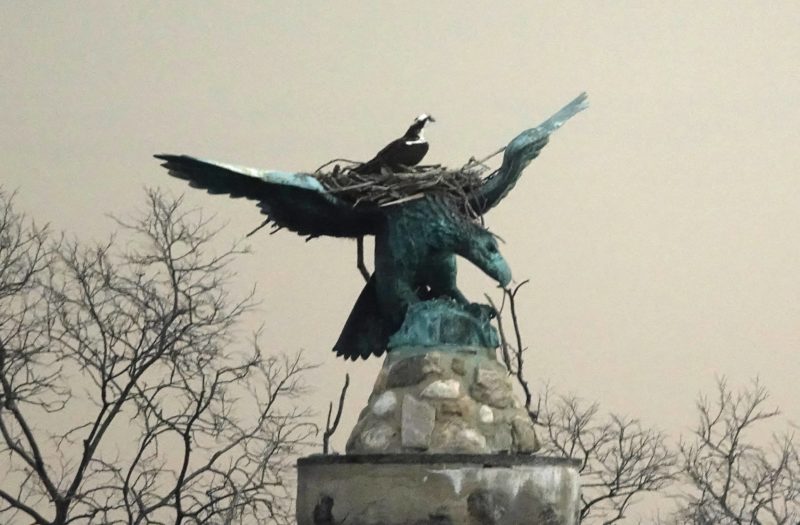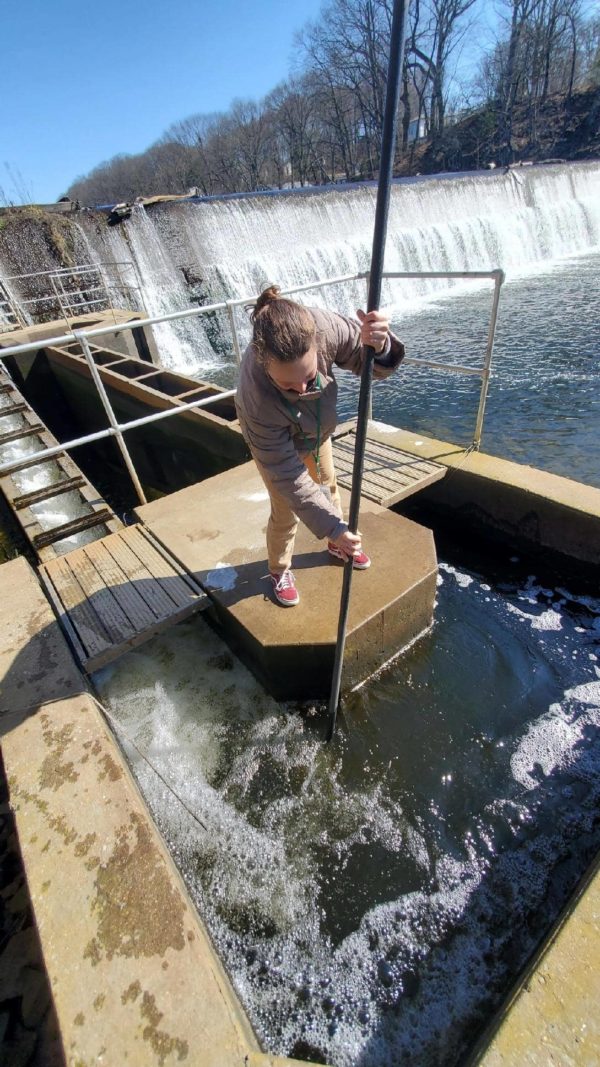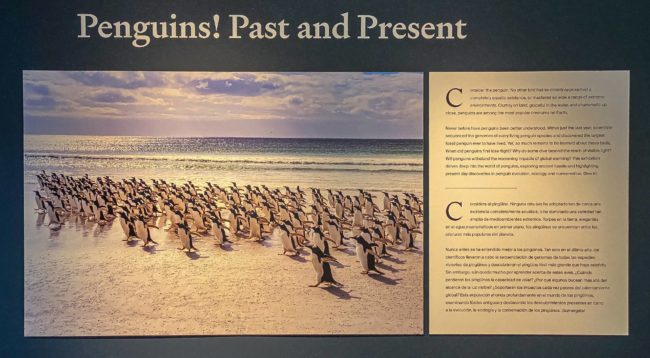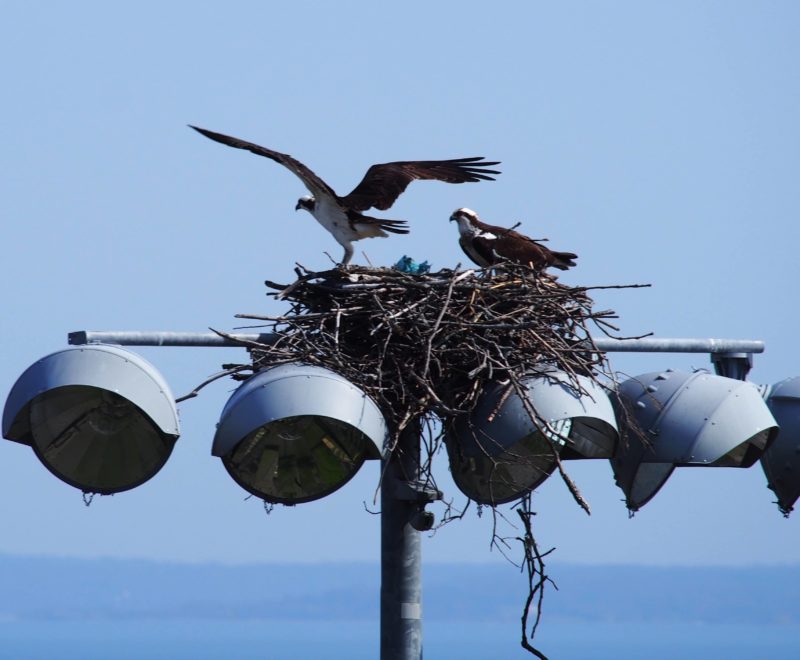
By Anne W. Semmes
What an exciting beginning of Earth Month in Greenwich. The ospreys are back from their great southern migration, reports noted birder Cynthia Ehlinger. “The last week in March seems to be when the first ones return,” she tells. [Cynthia leads the First Sunday Bird Walks at Greenwich Point]. See her photo of the osprey captured March 30, returning to its august nest atop the Eagle overlooking Eagle Pond in Greenwich Point Park. And ospreys have returned to Riverside she tells, and Byram Park as well, tells my fellow osprey steward Steve Galkin.
But Cynthia also has news of her monitoring at the Mianus Pond Fishway – spied on Facebook! Those migrating alewives that are diadromous fish – meaning they live in salt water, but spawn in fresh water – are making their way up the Mianus Pond ladder over the dam to that fresh water. She recently counted 15 alewives making their way. Great to know that with this entry into fresh water the fishway thus increases biodiversity and health within Long Island Sound and the Mianus River!
Cynthia began monitoring a year ago and is one of 14 volunteers presently doing so. She comes on her appointed Saturday afternoons, and “generally when it’s near the high tide because the fish have a lot further to go if it’s low tide,” she tells. And there are “a number of species of fish,” she adds, like eels. “So, we’re looking for eels that will go up these little nets that are on the side of the dam. And they’re going up as young tiny glass eels. They’ll grow up in freshwater then breed back out in the Sargasso Sea [in the Atlantic Ocean] and then come back to spend more of their lives in the fresh water.”
So, when is this diadromous fish migrating season? “So, say mid-April as the water starts to get a little bit warmer and we get more sunlight,” Cynthia tells, “and then we will check them through the end of June.” And are volunteers needed? “If somebody was really excited about wanting to do it, they probably could fit them in as a backup, or if somebody else was wanting to drop out, it might be nice.” The person to contact is Rebecca Poirier, environmental analyst on the Conservation Commission who heads up the Fishway. Give her a call at 203-622-6461 with your interest.
You will find the Mianus Pond Fishway website at www.greenwichct.gov/309/Mianus-Pond-Fishway beautifully laid out and informative. And Rebecca has some good history of the Fishway. “The Mianus River Fishway is one of about 45 fishways in Connecticut,” she tells, “with two in Greenwich at the Mianus River and at the Davis Avenue Bridge.”

“The Mianus Fishway was first constructed in 1993,” she continues, “with the help of [now retired] Denise Savageau and the Conservation Commission. Since then, there have been walkways, a fish counter, and underwater cameras added. It opened May 27,1993 allowing diadromous fish access to the river.” And it is three main fish species volunteers are monitoring– the Alewife, the Blueback Herring, and the American Eel.
To actually see what goes on at that Mianus Pond Fishway there is a Fishway Open House scheduled on site, all afternoon on May 19. The Fishway is located next to the Greenwich Adult Day Care River House, 125 River Road Extension in Cos Cob. And Conservation Commission staff and volunteers will be on hand to lead participants on a tour and provide information about the fishway, the fishes that utilize it, and how it is operated!
Now it is time to share that other natural wonder newly arrived in Greenwich, the penguins found in the “Penguins! Past and Present” exhibition at the newly expanded Bruce Museum! Cynthia Ehlinger, who served two decades at the Bruce as science curatorial associate, highly recommends it. “There is a great diversity of penguins seen through the ages and even today there were penguins I wasn’t aware of,” she tells.
Visiting the Bruce Museum’s exhibit: Penguins Past and Present
Walking into the penguin exhibit in the brand-new Bruce the introduction states: “Penguins are among the most popular creatures on earth.” Easy to see in this exhibit I found filled with ecstatic young visitors.
Daniel Ksepka is the Bruce’s history-making Curator of Science who brought “Penguins! Past and Present” into being. He kindly stands in front of a gallery of photos showing that extraordinary diversity of penguins that amazed Cynthia – 20 species he has mounted. “That is one of the aspects of penguins that will surprise people,” he says, assuming “the average person thinks there’s like two or three species. People don’t realize how far across the southern hemisphere they’re distributed. They’re in deserts, they’re in forests, rocky islands – they’re even at the equator on the Galapagos Islands.”
And penguins are colorful! “They’re not just black and white birds standing on the ice in Antarctica. You have blues and yellows and oranges in their plumage.”
Daniel is often a discoverer of ancient penguins that existed as far back as that devastating asteroid that wiped out the dinosaurs over 60 million years ago. His latest of that period is a collaborative discovery – in February – of a penguin fossil found on the beaches of New Zealand that is the largest ever penguin known to have existed, called the Kumimanu that weighed in at 350 pounds, standing five feet five inches. There wasn’t time to build a model for the exhibit but on view is the next largest fossil discovery of Daniel’s, the “Giant” Penguin that lived 20 million years ago. It is named by Daniel the Kairuku grebneffi and would have towered over our largest living Emperor Penguin.
This magnificent display of life-size penguins began in the making in July of 2021 shares Daniel. “I visited the workshop several times during the process to look at the sketches, the little clay models, and talk about things like the beak, feathers, foot scales etc. So, it was definitely a big collaboration between the artist Jason Brougham and me.”
And that life reconstruction can extend back a decade, he tells, “because we got a really good understanding of the skeletal proportions of a giant penguin for the first time when we published that study on the Kairuku fossils in 2012.”
There is a beautiful display of our largest living Emperor with small offspring penguin, next to a display of our smallest living Little or Blue Penguin and its wee offspring. But the most winning single display for me was of a Blue Penguin whit its eye looking right at me. [So, why in my cruise around New Zealand didn’t I see one!!]
I also wondered at the displaying of a penguin’s ability to deep dive. The Emperor clocked at 1,853 feet – as compared to the height of the Empire State Building! The Adelie Penguin at 787 feet, compared to a human unassisted dive at 334 feet! And that little Blue Penguin at 220 feet.
So, Daniel, what is the daily life pattern of a penguin in general? “It depends on what species you’re talking about. So, the ones you’re looking at right here in general, will go out fishing and do their feeding for the day. If they’re raising chicks at that time [usually one chick], they’ll try to bring back extra food, which they basically regurgitate for the chicks. They will tend to spend the night on land. The smaller penguins typically go back to their nesting sites or burrows and spend the evening there. But some of the larger species will spend weeks or months away at sea. So, like the Emperor, once the breeding cycle’s over, they’ll be out in the open ocean for very long periods of time. They’ll basically sleep at the surface. So, they don’t need to step foot on land for quite some time. So, typically, smaller ones are more home bodies. Larger ones range farther throughout the year.”
“So, I asked Daniel, “I’ve read that penguins are sentinels of the health of our planet?” “We consider them sentinels maybe for two reasons. Many species are very sensitive to sea climate change. Many of the Emperor penguins never set foot on dry land. So, they’re coming ashore to breathe, but they’re actually standing on sea ice. So, there’s nothing under them except the ocean. They’re hardwired to return to that same breeding colony year after year. They lay their eggs there and then the ice melts too early in the year and the chicks fall into the water. There are many species that are sensitive to this.”
 “The other reason,” he continues, “I think they’re considered as sentinels is they’re so lovable and charismatic. Maybe they’re a flagship species more than a sentinel. People love them. It’s less easy to get people excited about a shrimp or a spider. So often conservation projects use this mascot kind of animal. And if you save the environment that this beloved species is living in, you save everything that’s living around it too.”
“The other reason,” he continues, “I think they’re considered as sentinels is they’re so lovable and charismatic. Maybe they’re a flagship species more than a sentinel. People love them. It’s less easy to get people excited about a shrimp or a spider. So often conservation projects use this mascot kind of animal. And if you save the environment that this beloved species is living in, you save everything that’s living around it too.”
So, where might Daniel’s dream penguin trip today take him? “Well, you know,” he says with a smile, “I study extinct penguins. So, the fossil sites that I’ve worked on are in Peru and in New Zealand, and those are two very good places to find the remains of extinct penguins.”
But to see living penguins, he tells, “My favorite spot is Phillips Island in Australia where you can see a couple hundred of these little Blues wandering in at the end of the day. They’re so cute and they’re so concentrated and you’ll see them walk right by you, a couple of feet in front of you.” And he adds, “I would love to see a few of the Antarctic species. I’ve never seen an Emperor in the wild.” He ends with a laugh, “I’d be more than happy to come up on a boat and take a look at some of those!”





